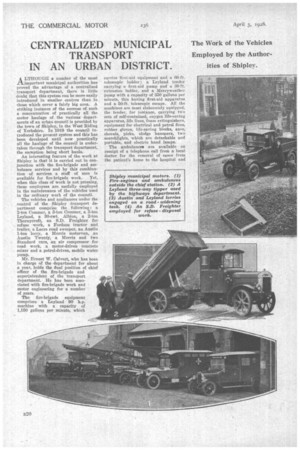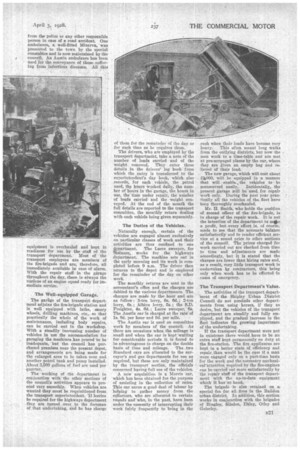CENTRALIZED MUNICIPAL The Work of the Vehicles TRANSPORT Employed by the Author IN AN URBAN DISTRICT. ities of Shipley.
Page 54

Page 55

If you've noticed an error in this article please click here to report it so we can fix it.
A LTHOUGH a number of the most 1--iimportant municipal authorities has proved the advantage of a centralized transport department, there is little doubt that this system can be more easily introduced in smaller centres than in those which cover a fairly big area. A striking instance of the success of such a concentration of practically all the motor haulage of the various departments of an urban council is provided by the town of Shipley, in the West Riding of Yorkshire. In 1919 the council introduced the present system and this has been developed until now practically all the haulage of the council is undertaken through the transport department, the exception being short hauls.
An intere-sting feature of the work at Shipley is that it is carried out in conjunction with the fire-brigade and ambulance services and by this combination of services a staff of men is available for fire-brigade work. Yet, when this class of work is not pressing, these employees are usefully employed in the maintenance of the vehicles used in the ordinary work of the council.
The vehicles and appliances under the control of the Shipley transport department comprise the . following: 2-ton Commer, a 3-ton Commer, a 3-ton Leyland, a 30-cwt. Albion, a 2-ton Tlkornycroft, an S.D. Freighter for refuse work, a Fordson tractor and trailer, a Lacre road sweeper, an Austiu 1-ton lorry, a Morris motorvan, an Austin Twenty, a Morris and two Standard cars, an air compressor -for road work, a motor-driven concrete mixer and a petrol-driven, mobile water pump.
Mr. Ernest W. Calvert, who has been in charge of the department for about a year, holds the dual position of chief officer of the fire-brigade and superintendent of the transport department. He has been associated with fire-brigade work and motor engineering for a number of years.
The fire-brigade equipment comprises a Leyland 90 h.p. machine with a capacity of 1,150 gallons per minute, which
carries first-aid equipment and a 60-ft. telescopic ladder ; a Leyland tender carrying a first-aid pump and a 30-ft. extension ladder, and a Merryweather pump with a capacity of 350 gallons per minute, this having first-aid apparatus and a 50-ft telescopic escape. All the machines are most elaborately equipped, the tender, for instance, carrying two sets of self-contained, oxygen life-saving apparatus, life lines, foam extinguishers, equipment for electrical and petrol fires, rubber gloves, life-saving blocks, axes, shovels, picks, sledge hammers, two searchlights, which are detachable and portable, and electric hand lamps.
The ambulances are available on receipt of a telephone call from a local doctor for the removal of cases from the patient's home to the hospital and
from the police or any other responsible person in ease of a road accident. One ambulance, a well-fitted Minerva, was presented to the town by the special constables and is now maintained by the council. An Austin ambulance has been used for the conveyance of those •suffering from .infectious diseases, All this
equipment is overhauled and kept in readiness for use by the staff of the transport department. Most of the transport employees are members of the fire-brigade and are, therefore, all immediately available in ease of alarm. With the repair staff in the garage throughout the day, there is always the nucleus of an engine squad ready for immediate service.
The Well-equipped Garage.
The garage of the transport departmeni adjoins the fire-brigade station and is well equipped with lathe, emery wheels, drilling machines, etc., so that practically the whole of the work of maintenance, including body repairs, can be carried out in the workshop. With a steadily increasing number of vehicles in use the atcommodation for garaging the machines has proved to be inadequate, but the council has purchased premises near the present depot, and arrangements are being made for the enlarged area to be taken over and another petrol tank and pump installed. About 3,500 gallons of fuel are used per quarter.
The working of the department in conjunction with the other sections of the council's activities appears to proceed very smoothly. When vehicles are wanted they must be requisitioned from the transport superintendent. If lorries be required for the highways department they are turned over to the foreman of that undertaking, and he has charge of them for the remainder of the day or for such time as he requires them.
The drivers, who, are employed by the transport department, take a note of the number of loads carried and of the 'weight removed. They enter these details in the drivers' log book from which the entry is transferred, to the superintendent's day book, which also record', for each vehicle, the petrol used, the hours worked daily, the number of hours in the garage, the hours in use, the time under repair, the number of loads carried and the weight conveyed. At the end of the month the full details are reported to the transport committee, the monthly return dealing with each vehicle being given separately.
The Duties of the Vehicles.
Naturally enough, certain of the vehicles are engaged almost exclusively on particular classes of work and their activities are thus confined to one epartment. The Lacre sweeper, for instance, works for the highways department. The ,machine sets out in the early morning and its work is completed before 9 a.m. The driver then returns to the depot and is employed for the 'remainder of the day on other work.
The monthly returns. are sent to the aecoantant's. office and the charges are debited to the various departments. The charges are made by the hour .and-ara. as follow: 8-ton lorry, 6s. 6d.; 2-ton lorry, 6s.; Albion lorry, 50.; the S.D. Freighter, 4s. lid.; Lacre sweeper,' 6s. The Austin ear is charged at the rate of is. 9d. per hour and 0d, per mile.
The Austin ear is used on committee work by members of the Connell. As there" are occasions when the mileage is small and when the ear is kept waiting for considerable periods it is fonnd to be advantageous to charge on the double basis of time and mileage. The two Standard cars are allocated to the surveyor's and gas departments for use as required, but these are only maintained by the transport sectiem, the officials concerned having full use of the vehicles.
A new acquisition is a Morris car, which has been obtained for the parpoSe of assisting in the collection of rates. This ear saves a good deal of labour by helping' to gather money from the collectors, who are allocated to certain rounds and who., in the past, have been under the necessity of interrupting their work fairly frequently to bring in the cash when their loads have become very heavy. This often meant long walks from the outlying districts, but now the men work to a time-table and are met at. pre-arranged places by the car, where they are given an empty bag and relieved bf 'their load.
The new garage, which will Cost about £.2e000, will be equipped in a manner that will enable.,the vehicles to'' be
manoeuvred easily. Incidentally, the present garage will he used for repair Woek only. During the past year practically all the vehicles of the fleet have been thoroughly civerhaulecl.
Mr. EL Smith, who holds the position of Second officer of the fire-brigade, is in charge of the repair work. It is not the intention of the department to mike a profit, but every effort is, of course, made to see that the accounts balance satisfactorily and to render.efficient service at a sound price to other sections of the council. The prices charged for work carried out are checked from time to time and adjustments are made accordingly, but it is stated that the charges are lower then hiring rates and, as a result, very little transport work is undertaken by contractors, this being only when work has to be effected in eases of emergency.
The Transport Department's Value.
The activities of the transport department of the Shipley Urban District Council do not preclude other departments from using horses, if they so desire, but the vehicles of the transport department are steadily and fully employed, and the gradual increase in the fleet indicates the growing importance of the undertaking.
If the traneport•department were not in existence there would have to be an extra staff kept permanently on duty at the Ere-station. The fire appliances are kept in a better state of efficiency aud repale,than would be the case if A man were engaged only on a part-time basis for the work and the necessary mechanical-attention, required by the fire-engines can be carried out more satisfactorily by the repair staff of the transport department with the up-to-date equipment -which it has n hand.
The brigade is also retained on a special fee for all fires in the Daildon urban district. In addition' this section works in conjunction with the brigades of Dingley, Silstlen, Ilkley, Otley and Guiscley.




















































































































